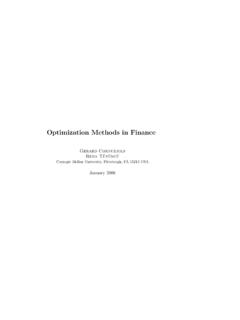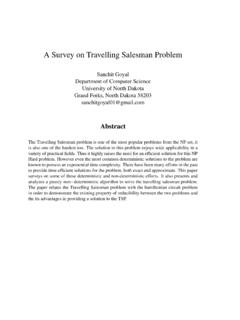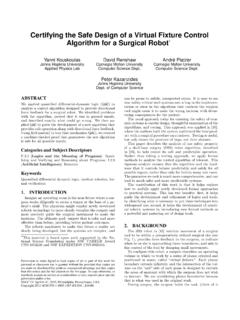Transcription of Alocal Fourierconvergenceanalysisof …
1 A local Fourier convergence analysis of a multigrid method using symbolic computation Veronika Pillwein Stefan Takacs DK-Report No. 2012-04 04 2012. A 4040 LINZ, ALTENBERGERSTRASSE 69, AUSTRIA. Supported by Austrian Science Fund (FWF) Upper Austria Editorial Board: Bruno Buchberger Bert J uttler Ulrich Langer Manuel Kauers Esther Klann Peter Paule Clemens Pechstein Veronika Pillwein Ronny Ramlau Josef Schicho Wolfgang Schreiner Franz Winkler Walter Zulehner Managing Editor: Veronika Pillwein Communicated by: Manuel Kauers Walter Zulehner DK sponsors: Johannes Kepler University Linz (JKU). Austrian Science Fund (FWF). Upper Austria A LOCAL FOURIER CONVERGENCE ANALYSIS OF A. MULTIGRID METHOD USING SYMBOLIC COMPUTATION. VERONIKA PILLWEIN AND STEFAN TAKACS. Abstract. For iterative solvers, besides convergence proofs that may state qualitative results for some classes of problems, straight-forward methods to compute (bounds for) convergence rates are of particular interest. A widely- used straight-forward method to analyze the convergence of numerical methods for solving discretized systems of partial differential equations (PDEs) is local Fourier analysis (or local mode analysis).
2 The rates that can be computed with local Fourier analysis are typically the supremum of some rational function. In the past this supremum was merely approximated numerically by interpo- lation. We are interested in resolving the supremum exactly using a standard tool from symbolic computation: cylindrical algebraic decomposition (CAD). In this paper we work out the details of this symbolic local Fourier analysis for a multigrid solver applied to a PDE- constrained optimization problem. 1. Introduction As mentioned in the abstract, in this work we introduce symbolic local Fourier analysis (sLFA) for analyzing the convergence behavior of a numerical method. Local Fourier analysis (or local mode analysis) is a commonly used approach for designing multigrid methods and analyzing their convergence properties. It dates back to the late 1970s when A. Brandt [2] proposed to use Fourier series in the analysis of multigrid methods. Local Fourier analysis provides a framework to analyze various numerical methods with a unified approach that gives quantitative statements on the methods under investigation, , it leads to the determination of sharp convergence rates.
3 Typically in multigrid theory the fact of convergence is shown and neither sharp nor realistic bounds for convergence rates are provided, cf. standard analysis [7]. Local Fourier analysis can be justified rigorously only in special cases, , on rectangular domains with uniform grids and periodic boundary conditions. How- ever, results obtained with local Fourier analysis can be carried over rigorously to more general classes of problems, cf. [3]. Moreover, it can be viewed as heuristic approach for a wide class of applications. We understand local Fourier analysis as a machinery, which we apply in this paper to a model problem and a particular multigrid solver. A similar viewpoint was taken in [19], where also a local Fourier analysis software was presented that can be configured using a graphical user interface and allows ot approximate (numerically). smoothing and convergence rates based on local Fourier analysis approaches for various problems and different multigrid-methods. 1991 Mathematics Subject Classification.
4 Primary 68W30, 65N12, 26D05, 65N55. The research was funded by the Austrian Science Fund (FWF): W1214-N15, projects DK6 and DK12, and grant P22748-N18. 1. 2 VERONIKA PILLWEIN AND STEFAN TAKACS. As a model problem for the proposed machinery, we choose the application of a multigrid method to a particular PDE- constrained optimization problem. This problem is characterized by a parameter-dependent linear system which is not pos- itive definite. Therefore the construction of a parameter-robust numerical method for such a problem is non-standard. More or less the same problem an the same smoother have been analyzed in [1] using classical local Fourier analysis, , there the smoothing rate was approximated numerically. Here we present a symbolic analysis providing sharp, exact upper bounds. Still, we keep in mind that this analysis can be carried over to a variety of other problems and other (multigrid). solvers. In [12] we used the proposed method for a one dimensional problem and proving smoothing properties only, which was a much easier task to handle.
5 The goal of the present paper is to demonstrate that the analysis can be carried out in an entirely symbolic way and as such leads to sharp estimates for the convergence rates also for two dimensional problems. Aiming at an audience from both numerical and symbolic mathematics we try to stay at an elementary level and keep this note self-contained. For deriving the explicit representation of the convergence rates, we use Cylindri- cal Algebraic Decomposition (CAD), a well established method in symbolic com- putation. It was introduced for solving the problem of quantifier elimination in the theory of real numbers. Below we see that the bound for the convergence rate is defined as the supremum over a certain rational function (after an appropriate rewriting). This allows us to invoke CAD in the solution of the problem. CAD has been applied earlier in the analysis of (systems of) ordinary and partial differential- difference equations [8], where the necessary conditions for stability, asymptotic stability and well-posedness of the given systems were transformed into statements on polynomial inequalities using Fourier or Laplace transforms.
6 This paper is organized as follows. In Section 2 the numerical method analyzed in this paper using symbolic local Fourier analysis is introduced. We recall the method of classical local Fourier analysis and present the setup for the model problem in Section 3. In Sections 4 and 5 the symbolic local Fourier analysis is carried out to give sharp bounds for the convergence rates in the one and two dimensional case, respectively. 2. Model problem The convergence analysis presented in this paper should be understood as a machinery that can be applied to various problems and solvers. The analysis is carried out for the optimization problem constrained to a partial differential equa- tion (PDE- constrained optimization problem), introduced in Subsection , and a multigrid solver, introduced in Subsection A PDE- constrained optimization problem. The analysis is carried out for the following model problem, which is an optimal control problem of tracking type. Problem Find state y and control u such that they minimize Z Z.
7 1 2 . J(y, u) := (y(x) yD (x)) dx + u2 (x) dx, 2 2 . SYMBOLIC LOCAL FOURIER ANALYSIS 3. subject to the elliptic boundary value problem (BVP). y = u in and y = 0 on . Here, for d = 1, 2, 3 the set Rd is a given domain with sufficiently smooth 2 2. boundary and is the standard Laplace operator, , := ( x2 + + x2 ). 1 d Moreover, the desired state yD and the regularization or cost parameter > 0 are assumed to be given. The solution of the optimal control problem is characterized by its optimality system (Karush Kuhn Tucker system or KKT-system), which consists of state y, control u and and Lagrange multiplier, say p. The relation u = 1 p follows directly from the KKT-system, which allows to eliminate u. This leads to the reduced KKT-system, which reads as follows. Problem Let yD L2 ( ) and > 0 be given. Find (y, p) X := V V :=. H01 ( ) H01 ( ) such that (y, ye)L2 ( ) + ( p, e y )L2 ( ) = (yD , ye)L2 ( ). ( y, e p)L2 ( ) 1 (p, pe)L2 ( ) = 0. y , pe) X. holds for all (e . R. Here, := ( x 1.)
8 , .. , x d ) is the (weak) gradient and (u, v)L 2 ( ) :=.. u(x) v(x) dx 2. is the standard scalar product on L ( ). The details can be found in literature, cf. [11, 13, 12] and others. For finding the approximate solution to this problem, we discretize the problem using finite elements. We assume to have for k = 0, 1, 2, .. a sequence of rectangular grids partitioning the given domain . The finite dimensional subspaces Vk V. consist of continuous functions which are bilinear on each rectangular element. Here, the dimension Nk depends on the grid level k. By Galerkin principle, we replace the original Hilbert space V by the subspaces Vk in Problem Assuming to have a nodal basis k := ( k,i )N i=1 for Vk , we can rewrite the (discretized). k optimality system in matrix-vector notation as follows: . Mk Kk yk gk = , Kk 1 Mk pk 0. | {z } | {z } | {z }. Ak := xk := f k :=. where the mass matrix Mk and the stiffness matrix Kk are given by Mk := (( k,j , k,i )L2 ( ) )N k i,j=1 and Kk := (( k,j , k,i )L2 ( ) )N.
9 I,j=1 , k respectively, and the right hand side vector g k is given by g k := ((yD , k,i )L2 ( ) )N. i=1 . k The symbols y k and pk denote the coordinate vectors of the corresponding functions yk and pk with respect to the nodal basis k . A multigrid method. In this subsection we briefly introduce the multigrid framework that we want to analyze. Multigrid methods consist of two main parts: smoothing and coarse-grid correction. Intuitively speaking, the smoother is applied in order to reduce the amplitude of high-frequency modes of the defect, whereas the coarse-grid correction takes care of the low-frequency modes of the overall defect. The local Fourier analysis ensures this in a formal way. 4 VERONIKA PILLWEIN AND STEFAN TAKACS. (0). Starting from an initial approximation xk , one step of the multigrid method with pre + post smoothing steps for solving a discretized equation Ak xk = f k on grid level k is given by: Apply pre (pre-)smoothing steps (0,m) (0,m 1) (0,m 1). ( ) xk := xk + A 1.
10 K (f k Ak xk ) for m = 1, .. , pre (0,0) (0). with xk := xk , where the choice of the damping parameter and the preconditioner A k is discussed below. Apply coarse-grid correction (0, ). Compute the defect f k Ak xk pre and restrict to the coarser grid (grid level k 1). (1) (0, pre ). rk 1 := Pkk 1 (f k Ak xk ). Solve the problem (1). Ak 1 p(1). k 1. = rk 1. on the coarser grid. Prolongate the correction step to the finer grid (level k) and update the iterate (1, post ) (0, pre ) k xk := xk + Pk 1 p(1). k 1.. If the problem on the coarser grid is solved exactly (two-grid method), then we obtain (1, post ) (0, pre ) (0, pre ). xk := xk k + Pk 1 A 1 k 1. k 1 Pk (f k Ak xk ). Apply post (post-)smoothing steps (1,m) (1,m 1) (1,m 1). ( ) xk := xk + A 1. k (f k Ak xk ) for m = post + 1, .. , 0. (1) (1,0). to obtain the next iterate xk := xk . Here, the intergrid-transfer operators k Pk 1 and Pkk 1 are chosen to be block- diagonal, , Pkk 1. k . Pk 1. k Pk 1 = k and Pkk 1 = , Pk 1 Pkk 1. which means that the intergrid-transfer is done for the functions y and p sepa- rately.




